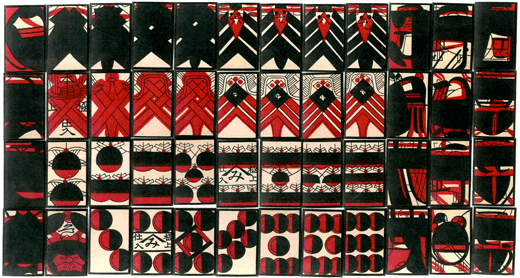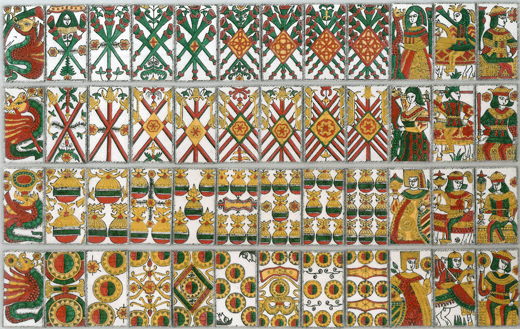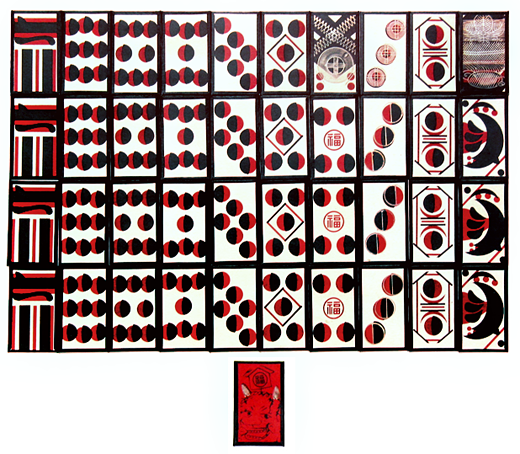Kabufuda (Angel)
Kabufuda. Angel, Japan. Bespoke deck, 41 single-headed cards. Size: 32mm x 53mm.
Deck make-up:
Suit of clubs: 1-9, jack (four copies of each; one copy of each of the 1 and 4 has a different design).
Extras: blank spare card.

 The first indigenous Japanese deck was the Tensho karuta (see near-right for a reconstruction) named after the Tensho period (1573–92). The deck was basically a copy of the cards used by Portuguese sailors, some of the few foreigners still allowed into Japan under the sakoku isolationist policy that started in the 1630s. It was a 48-card deck with the 10s missing like Portuguese decks of that period. It kept the four Mediterranean suits of clubs, swords, cups and coins, along with three court cards. The Tokugawa shogunate banned these cards, forcing Japanese manufacturers to radically redesign their cards a number of times over the subsequent years. The cards' design aspects became increasingly abstract and moved further and further away from their European roots, with each subsequent design revision (many of them region-specific) also being banned in turn by the authorities. (An example of one of these mekuri designs, in this case from Sakuragawa region, is shown far-right, above.)
The first indigenous Japanese deck was the Tensho karuta (see near-right for a reconstruction) named after the Tensho period (1573–92). The deck was basically a copy of the cards used by Portuguese sailors, some of the few foreigners still allowed into Japan under the sakoku isolationist policy that started in the 1630s. It was a 48-card deck with the 10s missing like Portuguese decks of that period. It kept the four Mediterranean suits of clubs, swords, cups and coins, along with three court cards. The Tokugawa shogunate banned these cards, forcing Japanese manufacturers to radically redesign their cards a number of times over the subsequent years. The cards' design aspects became increasingly abstract and moved further and further away from their European roots, with each subsequent design revision (many of them region-specific) also being banned in turn by the authorities. (An example of one of these mekuri designs, in this case from Sakuragawa region, is shown far-right, above.)
 Some decks, where suits were not a necessary feature of play, excerpted just one of the suits from these four-suited mekuri packs and repeated it a number of times. Such is a kabufuda deck, dating from the late 18th century, which is the suit of clubs (represented as thick black bars) repeated four times. Kabufuda is the last deck derived from the mekuri pattern still in production. Previously (though gone in recent years) was the komaru deck, where the suit extracted was coins (see right).
Some decks, where suits were not a necessary feature of play, excerpted just one of the suits from these four-suited mekuri packs and repeated it a number of times. Such is a kabufuda deck, dating from the late 18th century, which is the suit of clubs (represented as thick black bars) repeated four times. Kabufuda is the last deck derived from the mekuri pattern still in production. Previously (though gone in recent years) was the komaru deck, where the suit extracted was coins (see right).
Kabufuda cards are used for gambling games such as oicho-kabu. As in baccarat, the object of most kabu games is to get a total closest to nine.
Click on any card to explore the design.
(Comments or corrections, please e-mail: Click to see e-mail address.)
Cards
Earlier kabufuda decks sometimes still had the three court cards in the Japanese abstract mekuri style, but the modern pattern has settled on just one court card – a Western-style jack.
One copy (of the four) of the 1 and the 4 have a different style, as shown on the lower row, and includes the manufacturer's name and silver embellishments.
I have no idea what the Thermos-flask shape on the 1 is supposed to represent.
Extras

 The first indigenous Japanese deck was the Tensho karuta (see near-right for a reconstruction) named after the Tensho period (1573–92). The deck was basically a copy of the cards used by Portuguese sailors, some of the few foreigners still allowed into Japan under the sakoku isolationist policy that started in the 1630s. It was a 48-card deck with the 10s missing like Portuguese decks of that period. It kept the four Mediterranean suits of clubs, swords, cups and coins, along with three court cards. The Tokugawa shogunate banned these cards, forcing Japanese manufacturers to radically redesign their cards a number of times over the subsequent years. The cards' design aspects became increasingly abstract and moved further and further away from their European roots, with each subsequent design revision (many of them region-specific) also being banned in turn by the authorities. (An example of one of these mekuri designs, in this case from Sakuragawa region, is shown far-right, above.)
The first indigenous Japanese deck was the Tensho karuta (see near-right for a reconstruction) named after the Tensho period (1573–92). The deck was basically a copy of the cards used by Portuguese sailors, some of the few foreigners still allowed into Japan under the sakoku isolationist policy that started in the 1630s. It was a 48-card deck with the 10s missing like Portuguese decks of that period. It kept the four Mediterranean suits of clubs, swords, cups and coins, along with three court cards. The Tokugawa shogunate banned these cards, forcing Japanese manufacturers to radically redesign their cards a number of times over the subsequent years. The cards' design aspects became increasingly abstract and moved further and further away from their European roots, with each subsequent design revision (many of them region-specific) also being banned in turn by the authorities. (An example of one of these mekuri designs, in this case from Sakuragawa region, is shown far-right, above.) Some decks, where suits were not a necessary feature of play, excerpted just one of the suits from these four-suited mekuri packs and repeated it a number of times. Such is a kabufuda deck, dating from the late 18th century, which is the suit of clubs (represented as thick black bars) repeated four times. Kabufuda is the last deck derived from the mekuri pattern still in production. Previously (though gone in recent years) was the komaru deck, where the suit extracted was coins (see right).
Some decks, where suits were not a necessary feature of play, excerpted just one of the suits from these four-suited mekuri packs and repeated it a number of times. Such is a kabufuda deck, dating from the late 18th century, which is the suit of clubs (represented as thick black bars) repeated four times. Kabufuda is the last deck derived from the mekuri pattern still in production. Previously (though gone in recent years) was the komaru deck, where the suit extracted was coins (see right).





